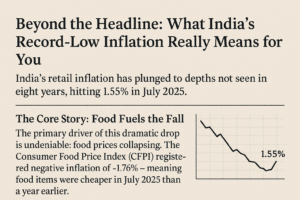Beyond the Headline: What India’s Record-Low Inflation Really Means for You
India’s July 2025 retail inflation plummeted to an 8-year low of 1.55%, primarily driven by a sharp decline in food prices (-1.76%). While this offers immediate relief to household budgets through lower grocery costs, it signals underlying economic stress. Farmers face income pressure as crop prices fall, potentially threatening future agricultural output. Critically, essential service costs remain stubbornly high—healthcare inflation rose to 4.57%, and urban housing held at 3.17%, squeezing discretionary spending.
The rural economy benefited most (inflation: 1.18%), but sustained food deflation risks weakening its recovery. This divergence creates a policy dilemma: the RBI faces pressure to cut interest rates despite anticipating inflation to rise above 4% by late 2026. The data reveals an economy where temporary price relief masks deeper challenges in balancing consumer benefits with farmer welfare and stable growth.

Beyond the Headline: What India’s Record-Low Inflation Really Means for You
India’s retail inflation has plunged to depths not seen in eight years, hitting 1.55% in July 2025. While this headline number sparks optimism about cheaper groceries, the reality beneath the surface reveals a more complex economic picture with significant implications for households, farmers, and policymakers.
The Core Story: Food Fuels the Fall
The primary driver of this dramatic drop is undeniable: food prices collapsing. The Consumer Food Price Index (CFPI) registered negative inflation of -1.76% – meaning food items were cheaper in July 2025 than a year earlier. This deflationary pressure was widespread:
- Rural (-1.74%) and Urban (-1.9%) areas both saw significant food price declines.
- Key contributors included falling prices for pulses, vegetables, cereals, eggs, and sugar.
Government statements attribute this partly to a “favorable base effect” (prices were unusually high last year) and specific price drops. Critically, food inflation fell by 75 basis points compared to June, hitting its lowest level since January 2019.
Beyond the Plate: A Tale of Two Economies
While food prices plummeted, the picture across other sectors was mixed, highlighting divergent pressures:
The Rural-Urban Divide:
- Rural India: Benefited most significantly. Headline inflation dropped sharply to 1.18% (from 1.72% in June), largely mirroring the steep fall in food prices (-1.74%).
- Urban India: Also saw improvement, but less dramatically. Headline inflation eased to 2.05% (from 2.56%) and food inflation deepened to -1.90%.
- Sticky Services Inflation: While food got cheaper, essential services saw persistent or rising costs:
- Health Inflation: Accelerated to 4.57% (up from 4.38% in June), squeezing household budgets, especially for non-discretionary spending.
- Education Inflation: Moderated but remained relatively high at 4.0% (down from 4.37%).
- Housing Inflation (Urban): Held steady at a significant 3.17%.
Why This Matters for You (The Human Insight):
- Short-Term Relief, Especially for Lower Incomes: Falling food prices offer immediate breathing room, particularly for low and middle-income households where food constitutes a larger portion of monthly spending. Grocery bills should feel lighter.
- The Farmer’s Dilemma: While consumers cheer, ultra-low or negative food inflation signals distress for farmers. Falling prices for crops like pulses and vegetables can erode incomes, potentially discouraging future planting and sowing the seeds for future price spikes. Reports of good monsoon coverage (90% of normal area sown) are positive, but excess rain later could damage yields.
- The Interest Rate Puzzle: With inflation falling well below the RBI’s 4% target midpoint and even breaching the lower bound (2%) of its tolerance band (2-6%), pressure mounts for further interest rate cuts. Lower rates could stimulate borrowing for homes and businesses. However, the RBI Governor has already cautioned that inflation is expected to rise above 4% by late FY26 due to base effects and demand factors. Stubbornly high service inflation (health, housing) also complicates aggressive rate cuts.
- A Fragile Recovery? The record-low inflation, while positive for consumers, partly reflects weak demand, particularly in rural areas. Reports like UBS Securities predicting a consumption pickup in the next 2-3 quarters hinge critically on continued good monsoons translating to better farm incomes and the impact of social welfare schemes. Negative food inflation could undermine this rural recovery.
- Affordable Housing at Risk? Anarock’s warning highlights an indirect consequence. Proposed US tariffs targeting Indian MSME exports could hurt the incomes of workers in these firms – a key demographic for affordable housing (sub-₹45 lakh). This could further dampen an already struggling segment of the real estate market.
Looking Ahead: Cautious Optimism
July’s 1.55% is a historic low, driven overwhelmingly by a temporary plunge in food prices. The key questions now are:
- How long will food deflation last? Will it start harming farm sustainability?
- When will sticky service inflation ease? Rising health costs are a major burden.
- Will the RBI prioritize growth or remain wary of future inflation? Further rate cuts seem likely but may be measured.
- Can rural demand truly rebound if farmer incomes are squeezed by low crop prices?
While cheaper groceries are welcome news today, India’s record-low inflation is a double-edged sword. It offers immediate consumer relief and room for potential economic stimulus but simultaneously signals underlying weaknesses in rural demand and potential future risks for both farmers and overall price stability. The path forward requires careful policy balancing to nurture a broad-based, sustainable recovery.
You must be logged in to post a comment.